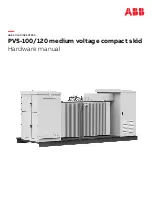
24
During stand-alone operation, power is supplied only to the stand-alone outlets. During a power outage, other outlets cannot be used.
• Use the stand-alone outlets.
Power output from the PV system and storage batteries can be unstable due to weather conditions and charge. If output drops,
stand-alone operation stops automatically.
• Electric appliances running off stand-alone operation may shut off.
There are some cases where the motors or some products which require massive amounts of electricity cannot be used. For more
details please contact the distributor.
• When power is supplied to electric appliances connected to the stand-alone outlets, inrush current may trip
protective devices and prevent the appliances from running.
• If stand-alone operation automatically stops due to high power consumption, the electric appliances that were
running stop temporarily. Although stand-alone operation resumes automatically when power consumption decreases,
connected appliances that have protective circuits are prevented from resuming operation.
The maximum amount of current that can be drawn during stand-alone operation is 16.7 A in THE-S55P3BB-USW, 27.5 A in
THD-S55P3BB-US, 16.7 A in THD-S55P3B-US. Only connect electric appliances that consume less than the maximum amount.
If the electric appliances connected to the stand-alone outlets consume more power than is generated by the PV system and
supplied by the storage batteries, stand-alone operation shuts down.
Many lighting fixtures and motor-driven appliances (e.g., vacuum cleaners. refrigerators, dryers, etc.) draw a large current when
turned on, and consequently will not run. Using these appliances may also trip protective circuits and keep them from running.
• There is a limit to the amount of power that can be drawn at one time.
• Stand-alone operation is automatically engaged if a power outage occurs.
Circuitry has been designed to enable lighting fixtures, communication equipment and other electric appliances to
be used in the event of a power outage without having to unplug and plug them back in again.
During the morning and daytime hours, the solar panels and storage batteries cooperatively supply the electric power
necessary for household consumption. Surplus power is used to charge the storage batteries. During the evening and
nighttime hours, power is supplied by the storage batteries.
■
Recharging the Storage Batteries using the Solar Panels
■
Electric Appliances Connected to Stand-alone Outlets during
an Outage Can Be Used without Plugging Them Back in.
Electric power generated by the solar panels can be efficiently stored in the storage batteries. This is useful during
extended power outages that last several days.
●
PROHIBITED
MANDATORY
The amount of electric power generated during stand-alone operation
varies according to weather and storage battery charge. The inverter
stops stand-alone operation if it generates less electric power than that
consumed by the electric appliances connected to its stand-alone
outlets. Do not use the appliances listed below with the inverter, as
personal injury or property damage may occur if the power shuts off.
• Any kind of medical or home security equipment.
• Desktop computers and other information-related equipment and
peripherals.
• Other equipment that may cause personal injury or property damage
if the power shuts off.
• Confirm the Backup Load Panel, related wiring, and electrical
fixtures are in good safe condition before commencing stand-alone
operation.
• If strange odors or noises are detected after starting
stand-alone operation, promptly stop stand-alone operation.
Do not connect the electric appliances listed below to the stand-alone outlets.
WARNING
CAUTION
• The desktop PC must be connected to the UPS as power will be temporarily disrupted when switching to
stand-alone operation.
• At extremely low SOC, the battery output power may be slightly decreased.
NOTE
Night
Morning
Afternoon
Evening
Night
Stand-alone Operation
(In a Power Outage)
■
Stand-alone Operation Precautions
















































